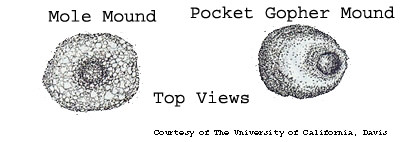It's an exasperating experience. You go to the nursery, pick out a flowering plant, shrub, or tree and bring it home only to have some critter damage or destroy it within the first week. Pests cause damage and waste time and money. The most common pests in the home landscape and garden are voles, moles, and gophers. By knowing what you're dealing with, it will be easier to eradicate the problem.
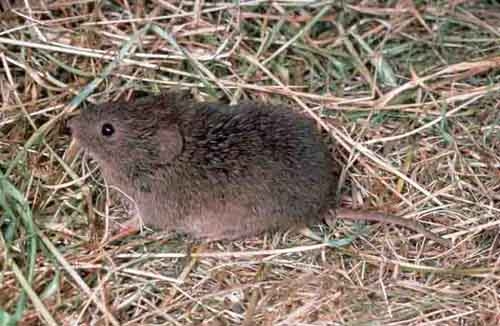
Voles are active both day and night and do not hibernate. They are shy creatures and build complex tunnels under dense ground cover such as lawns, grasses, and meadows. They live in colonies, spending most of their lives underground. Voles have an extremely short life cycle, living just three to six months, but females can become pregnant at three weeks old. The gestation period for female voles is sixteen to twenty-four days. A typical litter is five to eight baby voles. Young voles become self-sufficient after several days, at which time the mother vole moves on to find another partner to mate with. Because of their rapid reproductive rate, one mating vole pair can be responsible for producing one hundred voles (offspring, offspring of offspring, you get the picture) in a year. Even a single pair of voles can rapidly become a vole kingdom.
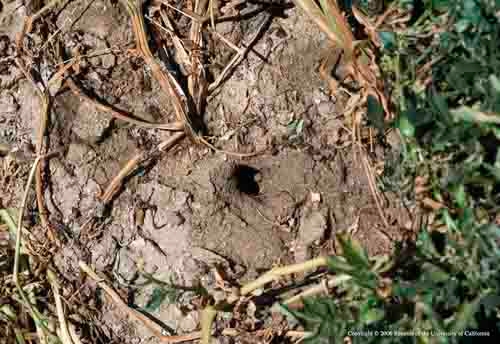
Modifying the habitat can be effective in controlling vole populations. Keeping the yard cleared of dense vegetation, any lawn mown, and shrub branches trimmed up off the ground can deter voles. Circling tree trunks with guard mesh is also helpful. Voles often thrive underneath weed cloth put down to prevent weeds from growing around ornamentals, and beneath mulch used to keep plant roots cool in the summer. Removing both is a deterrent tactic. It is also helpful to remove bird feeders, or control birdseed spillage. Keeping birdseed off the ground reduces food for voles.
Exclusion, repellants, and traps are more effective means of controlling voles. Hardware cloth (with one-quarter inch or smaller mesh) can be a useful barrier. The cloth can be fashioned into a fence at least twelve inches high and buried three inches in the ground to surround flower beds. Baskets can be made or purchased to protect trees and shrubs. Because coyote and fox urines are stressful to voles, application encourages them to move on. Coyote urine and fox urine can be purchased online. Repellants containing capsaicin (and active component of chili peppers) and thiram (a fungicide) have also proved to be effective on ornamental plants, but remember that repellants often wash away with rain and need to be reapplied. Although bait is not required, peanut butter mixed with oatmeal can be smeared on trap triggers when using mouse traps to eradicate voles. Two to three traps need to be set by each hole or runway. Baited traps need to be covered with a box or PVC pipe to deter other critters such as birds and squirrels. Make sure the box has a one-inch hole cut out in order to allow the vole to reach the trap.
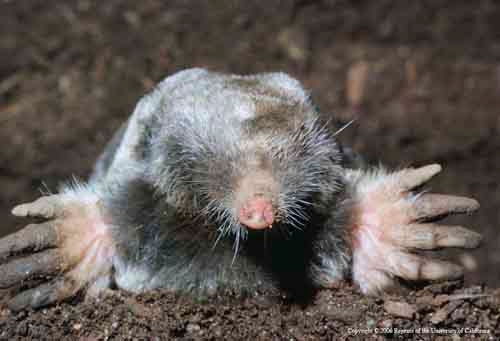
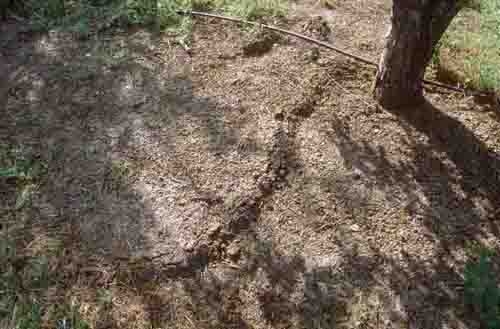
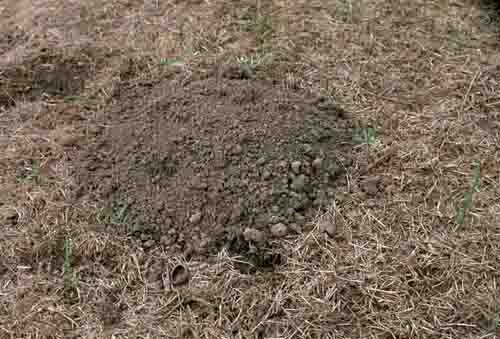
Gophers. Like voles, pocket gophers are rodents and herbivores. They prefer the fleshy underside of plants and roots. Called pocket gophers because of their furry cheek pouches that carry food and nesting materials, these critters are larger than either moles or voles, ranging from six to ten inches long. Gophers have long, yellow-orange front teeth, small eyes and ears, and short tails.
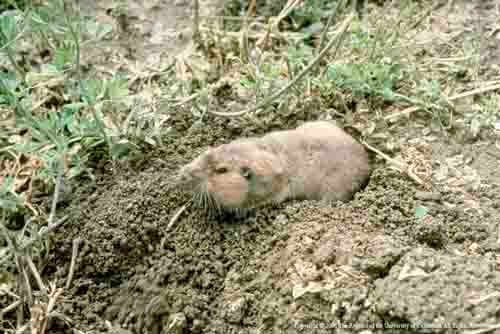
Gophers can wreak havoc on a row of plants by pulling entire plants down into their tunnels. They use their sense of smell to locate a source of food, preferring herbaceous plants, shrubs, and trees. Gophers will also gnaw on drip irrigation tubes and hoses.
Gophers reach sexual maturity at one year. Females produce up to three litters a year, with an average of five to six offspring per litter. Gophers live alone in their burrows except when females are caring for their young or during mating system. Since gophers can live up to three years, a gopher colony can become quite large over time.
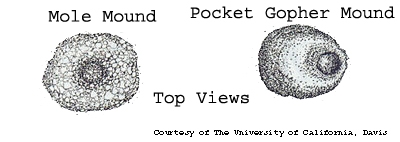
Voles, moles, and gophers can wreak havoc in the garden but they can be managed using various methods to control, deter, or eradicate. Consider your natural environment, whether children and pets can be harmed by deterrents, the expense of the deterrent method, and your commitment to the program of eradication when choosing a plan to deal with these pests.
For further information, see Kim Pokomy, Moles, voles and gophers dig the garden | OSU Extension Service (oregonstate.edu).
For in-person help in dealing with these critters (including a demonstration on exactly how to set a gopher trap), attend our free workshop on gophers, moles, and voles October 9th, part of the Master Gardeners' Fall 2024 Workshop Series. For details, and to register, visit our website.
UC Master Gardeners of Butte County are part of the University of California Cooperative Extension (UCCE) system. To learn more about us and our upcoming events, and for help with gardening in our area visit our website. If you have a gardening question or problem, email the Hotline at mgbutte@ucanr.edu or leave a phone message on our Hotline at 530-552-5812. To speak to a Master Gardener about a gardening issue, or to drop by the MG office during Hotline hours, see the most current information on our Ask Us section of our website.
It's an exasperating experience. You go to the nursery, pick out a flowering plant, shrub, or tree and bring it home only to have some critter damage or destroy it within the first week. Pests cause damage and waste time and money. The most common pests in the home landscape and garden are voles, moles, and gophers. By knowing what you're dealing with, it will be easier to eradicate the problem.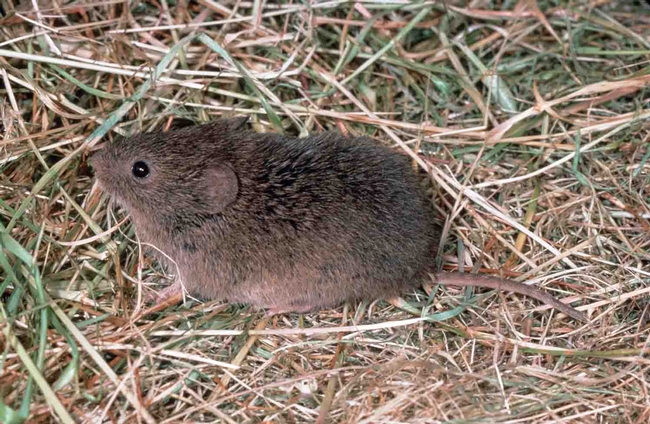
Voles. Also referred to as field or meadow mice, voles are small rodents three to nine inches in size (depending upon the species). They look a lot like hamsters, which are their close relatives. Damage done by voles is often mistaken for that of gophers. Voles are herbivores; they can gnaw on the bark of trees and shrubs, or simply eat the roots. They will also eat the tops of new vegetable transplants, leaving behind damage similar to deer nibbling. If you look closely, you'll see the vole's teeth marks on the stalk of the plant.
Voles are active both day and night and do not hibernate. They are shy creatures and build complex tunnels under dense ground cover such as lawns, grasses, and meadows. They live in colonies, spending most of their lives underground. Voles have an extremely short life cycle, living just three to six months, but females can become pregnant at three weeks old. The gestation period for female voles is sixteen to twenty-four days. A typical litter is five to eight baby voles. Young voles become self-sufficient after several days, at which time the mother vole moves on to find another partner to mate with. Because of their rapid reproductive rate, one mating vole pair can be responsible for producing one hundred voles (offspring, offspring of offspring, you get the picture) in a year. Even a single pair of voles can rapidly become a vole kingdom.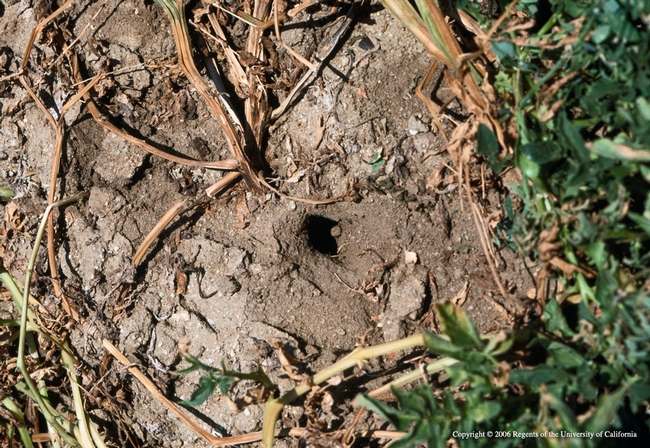
If you don't take measures to control voles when you first notice evidence of their presence, they can quickly create a problem that spirals out of control. Signs of vole infestation include holes with a surface diameter of around one and a half inches close to their surface runways (raised ground on top of their tunnels). Damage to the roots of trees, yellowed and wilting plants, missing bulbs, teeth marks around the bottom of trees and shrubs, and irregular paths of one to two inches of trampled grass or soil are also signs of vole infestation.
Modifying the habitat can be effective in controlling vole populations. Keeping the yard cleared of dense vegetation, any lawn mown, and shrub branches trimmed up off the ground can deter voles. Circling tree trunks with guard mesh is also helpful. Voles often thrive underneath weed cloth put down to prevent weeds from growing around ornamentals, and beneath mulch used to keep plant roots cool in the summer. Removing both is a deterrent tactic. It is also helpful to remove bird feeders, or control birdseed spillage. Keeping birdseed off the ground reduces food for voles.
Exclusion, repellants, and traps are more effective means of controlling voles. Hardware cloth (with one-quarter inch or smaller mesh) can be a useful barrier. The cloth can be fashioned into a fence at least twelve inches high and buried three inches in the ground to surround flower beds. Baskets can be made or purchased to protect trees and shrubs. Because coyote and fox urines are stressful to voles, application encourages them to move on. Coyote urine and fox urine can be purchased online. Repellants containing capsaicin (and active component of chili peppers) and thiram (a fungicide) have also proved to be effective on ornamental plants, but remember that repellants often wash away with rain and need to be reapplied. Although bait is not required, peanut butter mixed with oatmeal can be smeared on trap triggers when using mouse traps to eradicate voles. Two to three traps need to be set by each hole or runway. Baited traps need to be covered with a box or PVC pipe to deter other critters such as birds and squirrels. Make sure the box has a one-inch hole cut out in order to allow the vole to reach the trap.
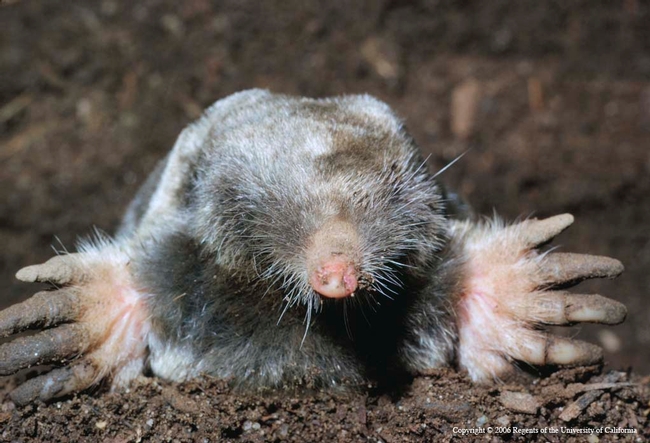
Moles. While there is only a one-letter difference between moles and voles, that's where the similarities stop. Moles are five to seven inches long and have long, fleshy noses which serve as touch organs. The feet, nose, and tail of a mole are pink. Moles have no external ears. Their eyes are buried in their fur, and their broad front feet are equipped with super-sharp claws for digging. Moles are mammals, not rodents, eating worms, ants, and grubs (certain beetle larvae). Many people attempt to control moles by eliminating their food source, but this has proved to be a difficult strategy because of a mole's varied diet. Eliminating grubs in a lawn will only lead moles to turn to earthworms in garden beds. But earthworms are good for our soil and leave behind beneficial castings.
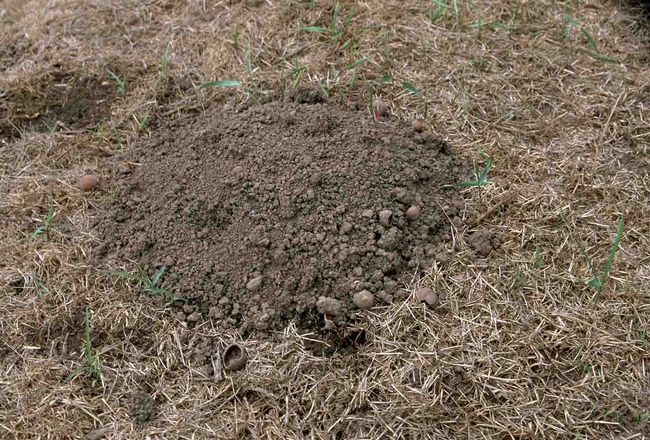
Moles live entirely underground and can tunnel one foot per minute, creating extensive tunnels and volcanic-shaped mounds when breaking ground. A mole's damage to a lawn or plant is accidental since they, unlike voles, don't eat plants. Most of the time, a mole causes little damage other than an unsightly raised bed or a tunnel in the lawn. In a way, they're actually helpful critters as they aerate the soil. Moles produce one litter per year in the spring, and in four to eight weeks young moles reach adult size. They're active year-round but male moles are especially active in February and March when looking for a female, and females are most active in May and June when they are feeding their young.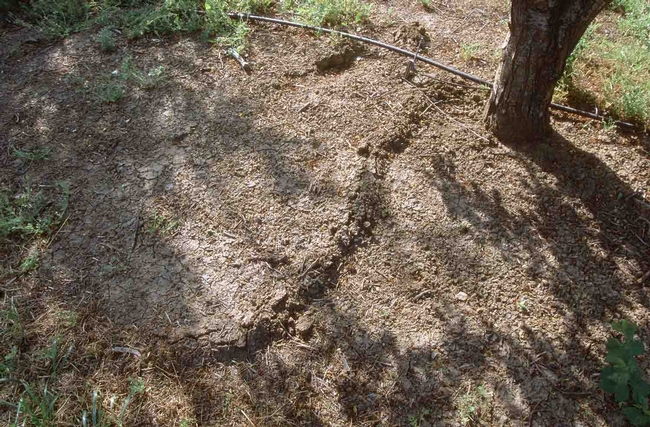
Since modifying the environment means ridding the soil of beneficial insects and worms, the only effective way to completely eliminate moles is by trapping. Traps are readily available in hardware and big box stores. If you don't mind moles, but don't want them in specific areas of your garden, repellants may work. Castor oil is a common mole repellant, but its efficacy is disputed. Sonic repellants, both solar and battery operated, emit vibrations that may scare away moles. The frequency isn't audible to humans and isn't harmful to children, pets, and other wildlife.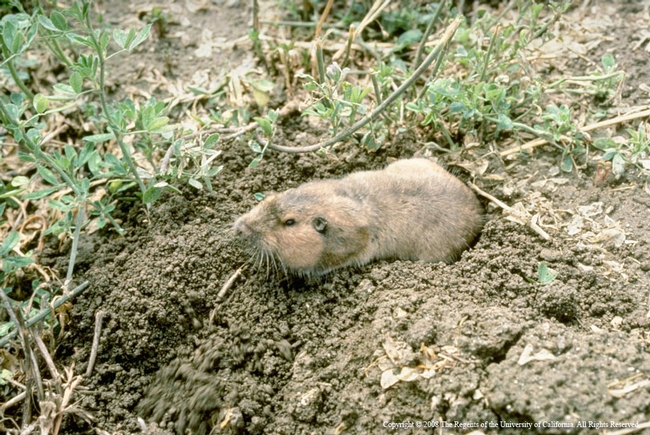
Gophers. Like voles, pocket gophers are rodents and herbivores. They prefer the fleshy underside of plants and roots. Called pocket gophers because of their furry cheek pouches that carry food and nesting materials, these critters are larger than either moles or voles, ranging from six to ten inches long. Gophers have long, yellow-orange front teeth, small eyes and ears, and short tails.
Five gopher species live in California. The most common is Botta's pocket gopher, T. bottae. These pests create an extensive underground burrowing system. Feeding tunnels are usually six to twelve inches below the surface. Nesting and food storage tunnels can be as deep as six feet below the surface. Gopher mounds are crescent-, horseshoe-, or fan-shaped, with a hole that is off to the side and usually plugged. One gopher can create several mounds in a day. Sometimes a gopher can be seen pushing dirt from a mound or feeding at the edge of a mound. They don't hibernate, tunneling through soil all year long, day and night.
Gophers can wreak havoc on a row of plants by pulling entire plants down into their tunnels. They use their sense of smell to locate a source of food, preferring herbaceous plants, shrubs, and trees. Gophers will also gnaw on drip irrigation tubes and hoses.
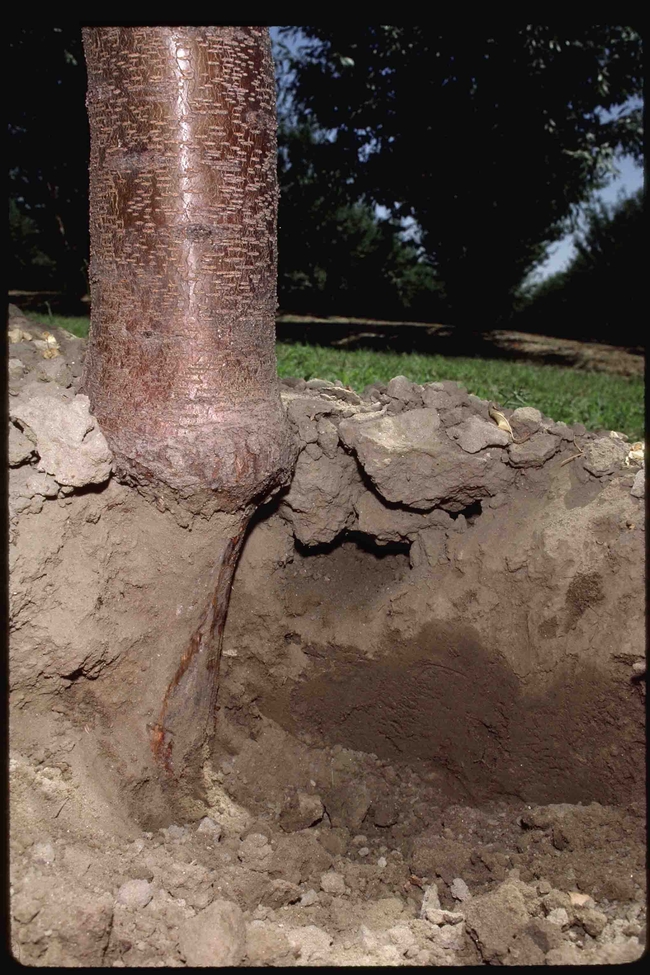
As with moles, trapping is the most effective way to eradicate the problem of gopher infestation. Make sure children and pets stay away from the traps, because the traps can cause injury. Employing gopher baskets and mesh barriers is an effective alternative. While some roots will escape the barrier, the main roots near the base of a plant will be protected. Sonic repellants my also deter these rodents.
Voles, moles, and gophers can cause havoc in the garden but they can be managed using various methods to control, deter, or eradicate. Consider your natural environment, whether children and pets can be harmed by deterrents, the expense of the deterrent method, and your commitment to the program of eradication when choosing a plan to deal with these pests.
For further information, see:
Baldwin, Roger A, UC IPM's Pest Note on Pocket Gophers.
“Controlling Vole Damage,” University of Nebraska-Lincoln Extension Publications
Pokomy, Kim, “Moles, Voles and Gophers Dig in the Garden,” Oregon State University Cooperative Extension.
Yordan Z, Vole Lifespan and Life Cycle, Insect Cop, May 13, 2020.
UC Master Gardeners of Butte County are part of the University of California Cooperative Extension (UCCE) system. To learn more about us and our upcoming events, and for help with gardening in our area, visit our website. If you have a gardening question or problem, email the Hotline at mgbutte@ucanr.edu (preferred) or call (530) 538-7201.
